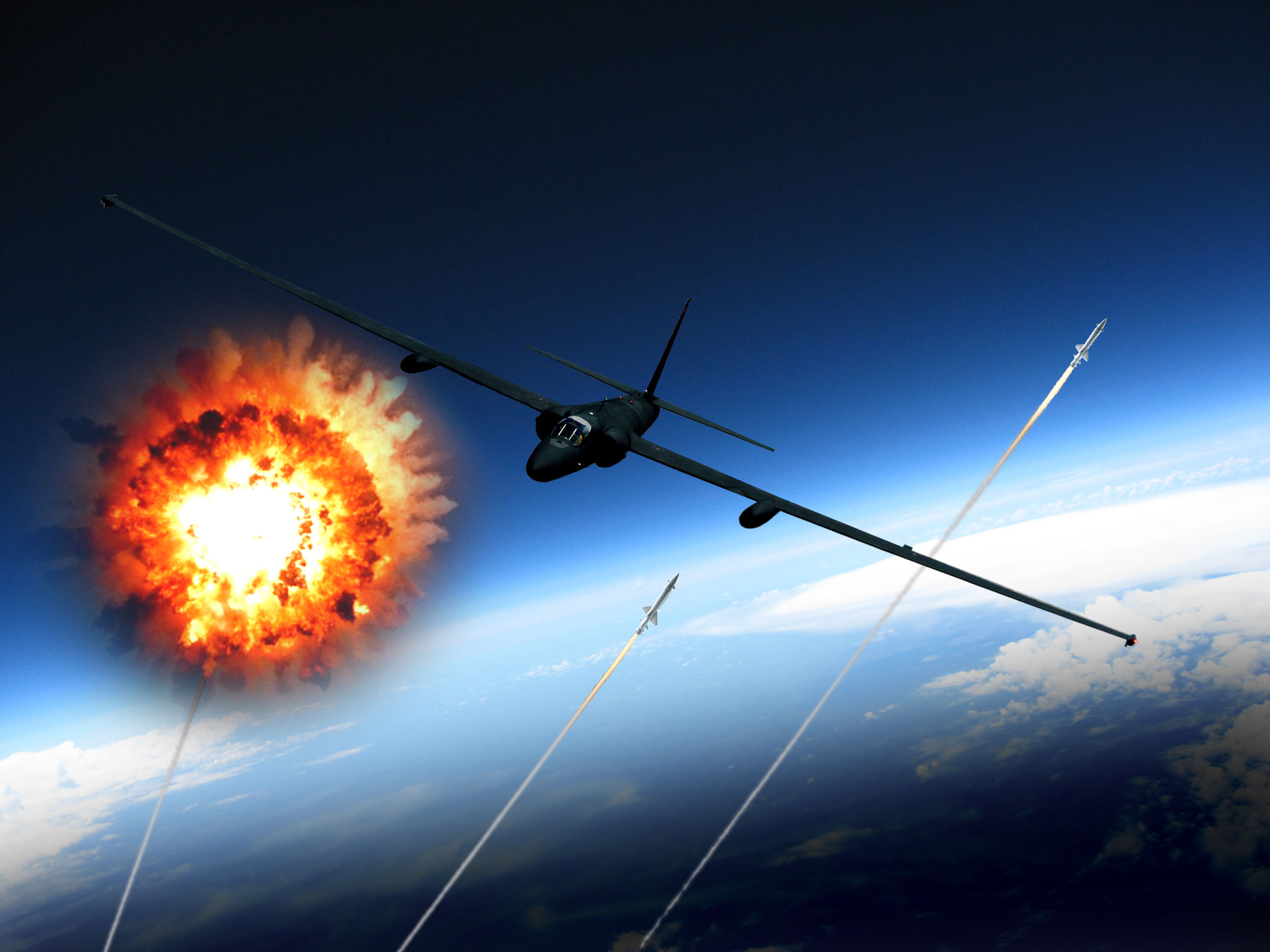





1 May 1960: 70,500 feet over Sverdlovsk, USSR, U‑2 pilot Francis Gary Powers runs afoul of three Soviet SA-2 Guideline missiles
After a Russian missile made “just one more” U.S. spy plane flight the last, American pilot Francis Gary Powers found himself facing KGB interrogators in Moscow while Dwight Eisenhower faced embarrassment at home.
|
As seen in the January 1994 issue of AVIATION magazine 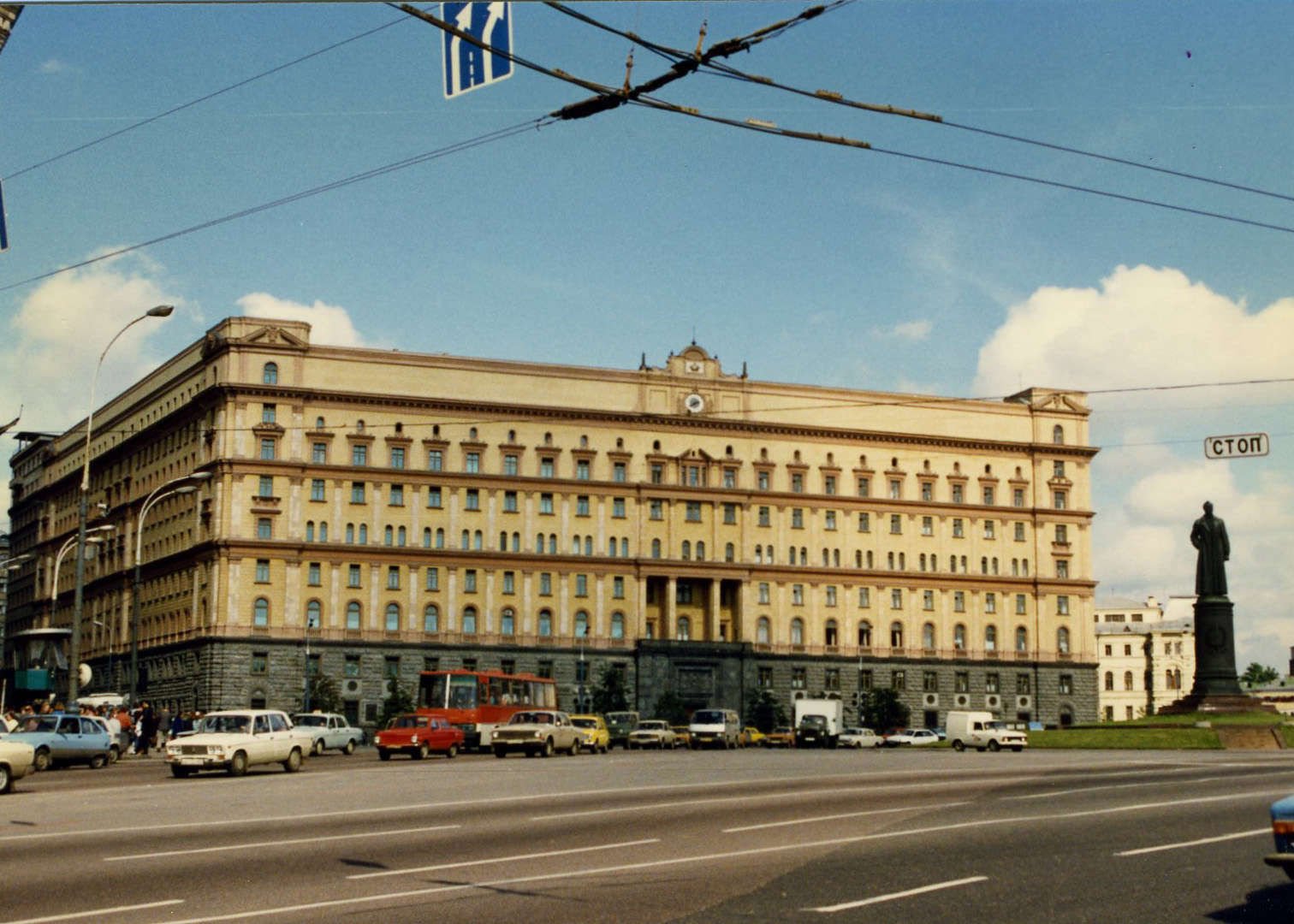
Lubyanka Prison, Moscow. Headquarters of the KGB. Statue at right of Felix Dzerzhinsky, founder of the Cheka, the Soviet secret police. For an interrogation chamber in Moscow’s infamous Lubyanka prison, headquarters of the KGB, the room was surprisingly roomy and well-lit. The prisoner wore a freshly blackened eye and, to replace his confiscated flight uniform, a shabby, too-large suit, pants without a belt and shoes without laces, to prevent him from hanging himself. He was brought in and seated at one end of a long table, an interpreter on one side and KGB interrogators on the other. The stenographer entered the date—May 1, 1960—and, as the questions and answers began, started typing: What is your name? Francis Gary Powers. What is your nationality? American. What type of aircraft were you flying? A Lockheed U‑2. Why did you fly over Russia? Powers had insisted he had simply wandered off course and crossed into the Soviet Union unintentionally. But he had been shot down over Sverdlovsk, more than 1,300 miles inside the border, and his captors had recovered a wealth of incriminating evidence from his person and the wreckage of his aircraft: detailed flight maps, a Department of Defense/Department of the Air Force ID card, Russian rubles, gold francs, a hunting knife, a silenced .22 pistol, and a seemingly innocuous pin found in the prisoner’s pocket. Powers warned his captors to handle that last item with extreme caution. Closer examination revealed the pin to be a sheath for an even smaller, extremely sharp needle. Tipped with curare. 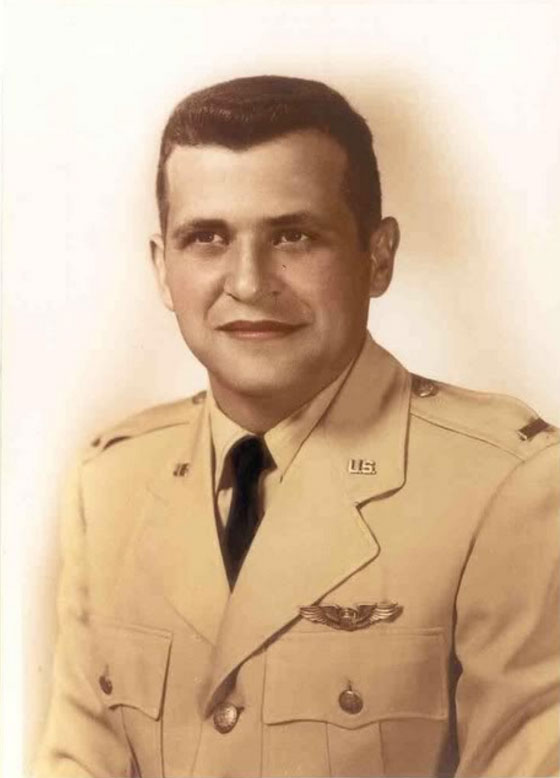
Lt. Francis Gary Powers 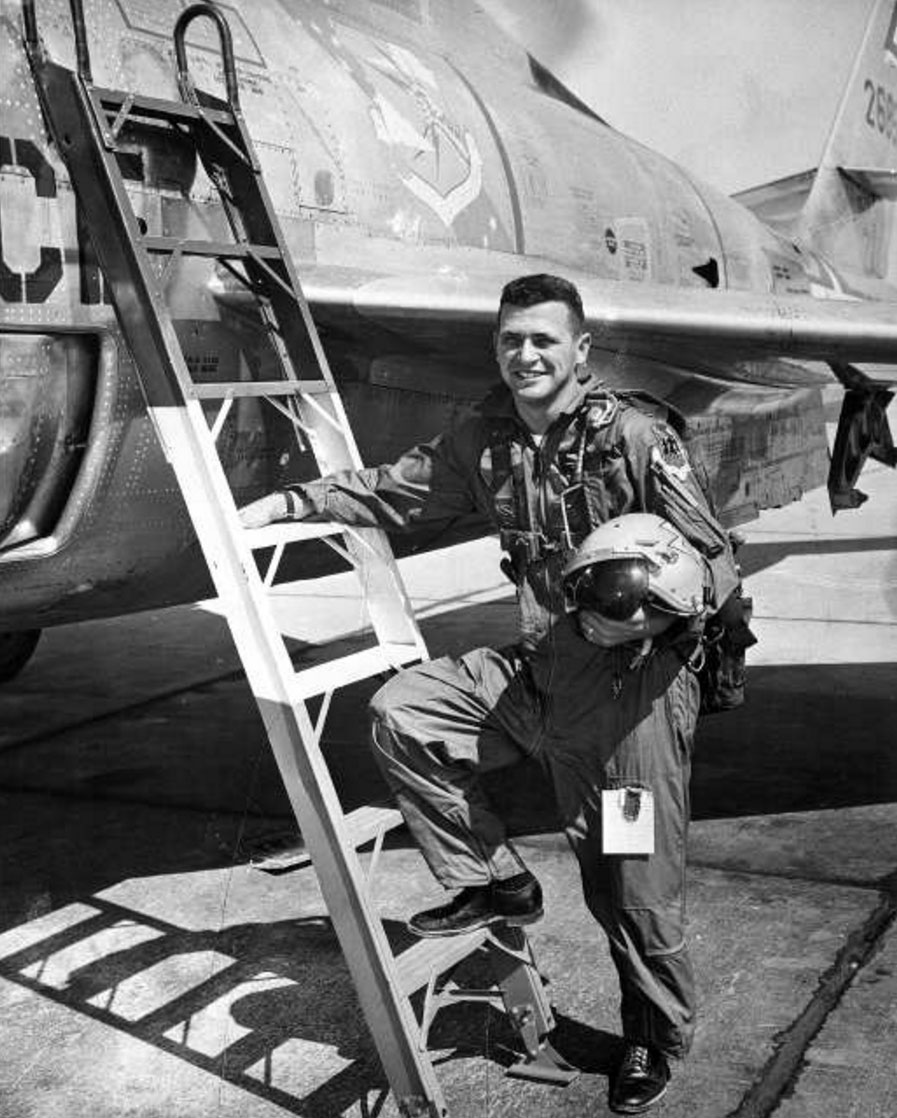
Powers as F-84 Thunderjet pilot In 1956, 1st Lt. Francis Gary Powers, son of a Virginia coal miner, had been a 26-year-old U.S. Air Force fighter pilot flying Republic F-84G Thunderjets. He excelled at aerial gunnery, was trained in aerial photography work and atomic weapons delivery, and had a corresponding “Top Secret” rating. But he had graduated from high school too late for World War II and from aviation cadet training too late for the Korean War, and he still felt he had something to prove. On Soviet Aviation Day in 1955 (May 1, popularly referred to as May Day), Western observers in Moscow had watched, awestruck, as formation after formation of new Myasishchev Mya-4 “Bison” jet bombers thundered overhead. Washington then had no means to dispel growing fear of a “bomber gap,” despite secret, short-range incursions into the Soviet Union by spying U.S. Air Force fighters and bombers. Many of these spy planes did not return, however, and the Soviet interior was as unknown to America as the New World was to medieval Europe. President Dwight D. Eisenhower’s “Open Skies” policy, an effort to bare both the United States’ and Soviets’ military programs to international scrutiny, had been rejected by Nikita Khrushchev, the Soviet premier. The Central Intelligence Agency (CIA) issued a requirement for an airplane that could overfly Russia—with or without Soviet permission. 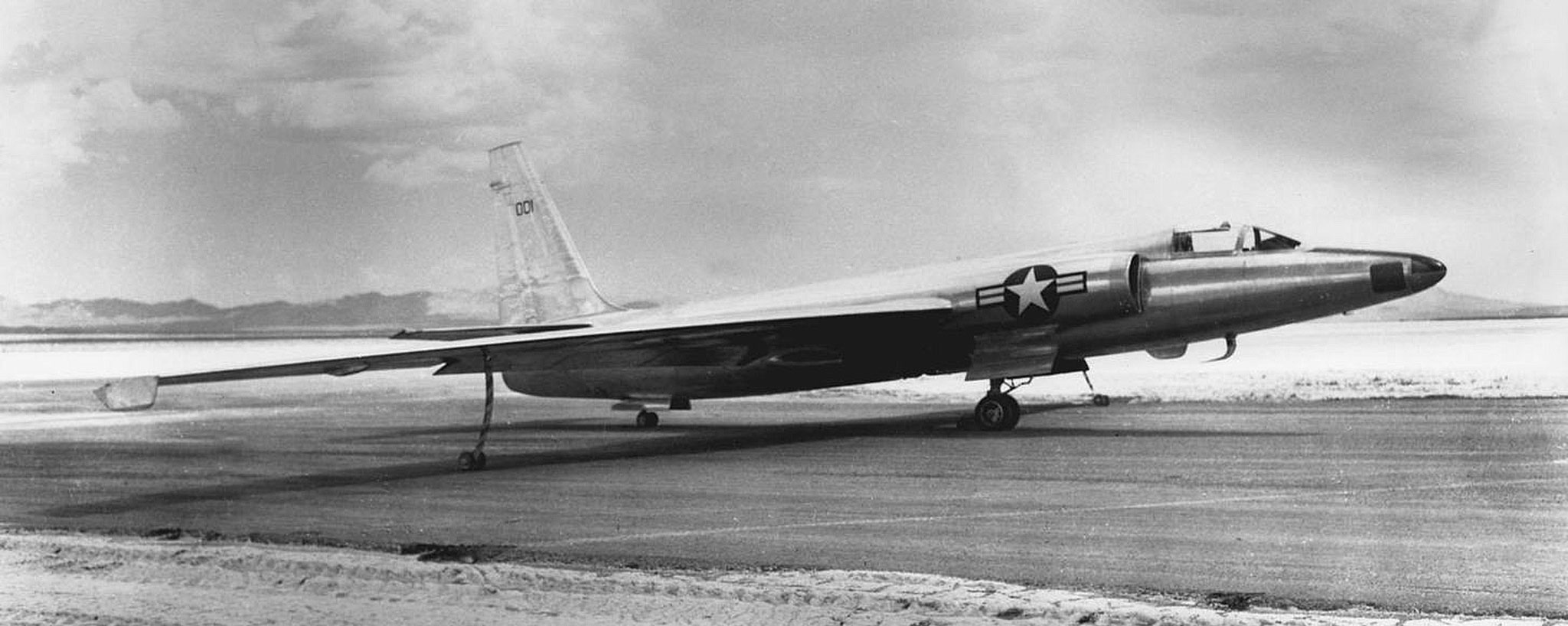
U-2 prototype, “Article 341” Though it wore US AIr Force insignia, the U‑2 was wholly owned by the CIA. On 29 July 1955, Lockheed test pilot Tony LeVier conducted the first taxi tests. On the third run he gained enough speed that the aircraft inadvertently took off, rising to 35 feet. To get it back down LeVier had to put it into a stall. The aircraft landed hard, blowing out both main tires and damaging the tail wheel. Note “001” tail number. In response, Lockheed’s special design unit, known as the “Skunk Works,” produced a jet-powered sailplane weighing just 6 tons empty,
The CIA offered crack fighter pilot Francis Gary Powers $30,000 a year—over a quarter of a million in today’s dollars—to fly its top-secret bird higher than anyone had ever flown before. Over Soviet Russia. 
Ground crewmen prepare a CIA U‑2 with NACA (National Advisory Committee for Aeronautics) markings for a training flight at Watertown Strip, Nevada. Where did you learn to fly the U‑2? In the United States. Where in the United States? A base on the West Coast. What is it called? Watertown. To insiders, Watertown Strip, in the remote Nevada desert, was known as “Paradise Ranch.” A 1956 press release had admitted its existence, as well as that of the U‑2, under the cover of “upper atmosphere research.” The only research Powers and the rest were doing was to stretch the U‑2’s operating limits, or envelope. In thin stratospheric air, the margin between its top and stall speeds amounted to just a few knots, and was known to the pilots as the “coffin corner.” If the pilot allowed the airplane to speed up slightly, it would get into the dangerous area of compressibility, near the sound barrier; let it slow down slightly and a stall would result that would require thousands of feet for recovery—if it could recover at all. The engine, capable of only 6 percent of its sea-level thrust at operating altitude, would flame out from oxygen starvation at 74,600 feet, necessitating a 30,000-foot dive to a restart. Early on, as many as six flameouts occurred on a single flight, but then from 70,000 feet the U‑2 could glide 300 miles even without power. 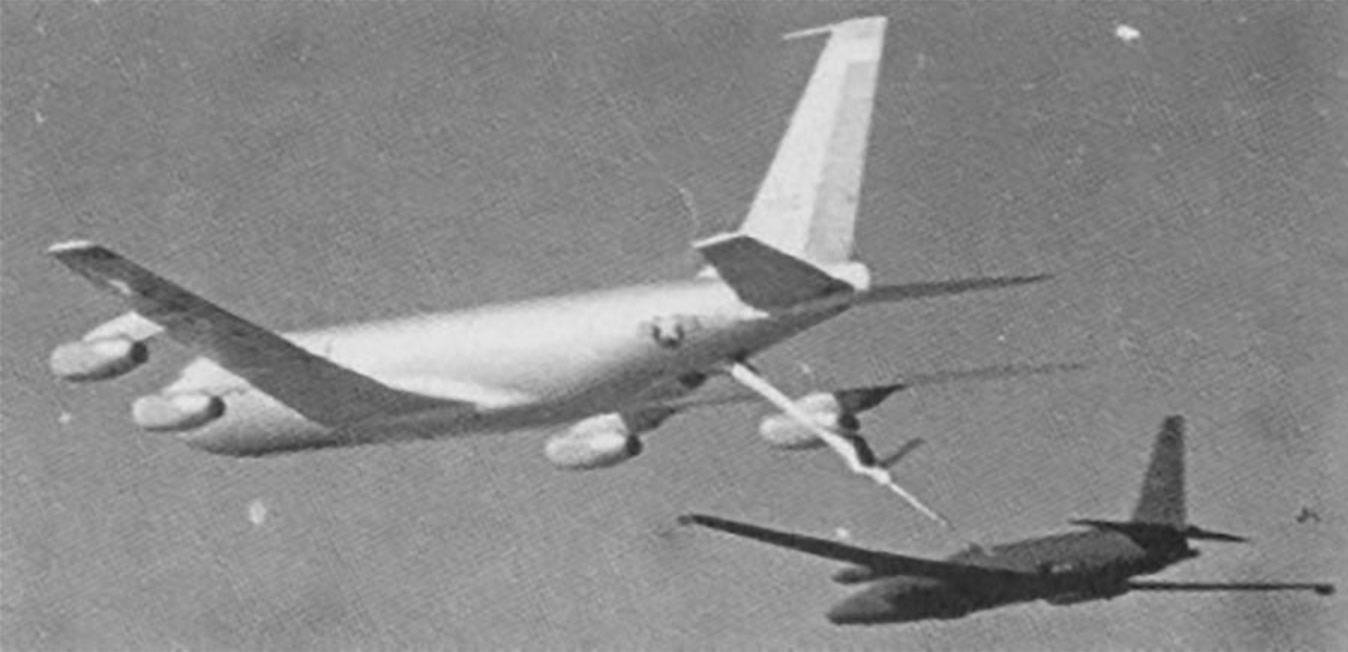
At sea level the J57 drank nearly 9,000 pounds of fuel per hour, but at 70,000 feet just 700 pounds per hour. Shell Oil Company developed a special low-vapor kerosene fuel, LF-1A, specifically for the U‑2, that would not boil or freeze at the low temperatures and air pressures encountered at altitude. Nicknamed “lighter fluid” for its smell, it was chemically closer to a popular bug spray of the day called “Flit.” It's said that in the summer of 1955, Shell diverted so many thousands of gallons of Flit to make LF-1A that it caused a nationwide shortage. Also, the lift generated by all that wing area meant the plane would fly even with the engines idled, but also made it reluctant to land. It would tend to form an air cushion and porpoise just above the runway unless the pilot put it into a stall. Then, unless he had perfectly balanced his fuel load between the wings, the plane might tip over on the bicycle landing gear, dig in one of the wingtip skids and do a ground loop. The previous class at Watertown had suffered a fatality when a pilot miscalculated his approach and crashed on the strip. 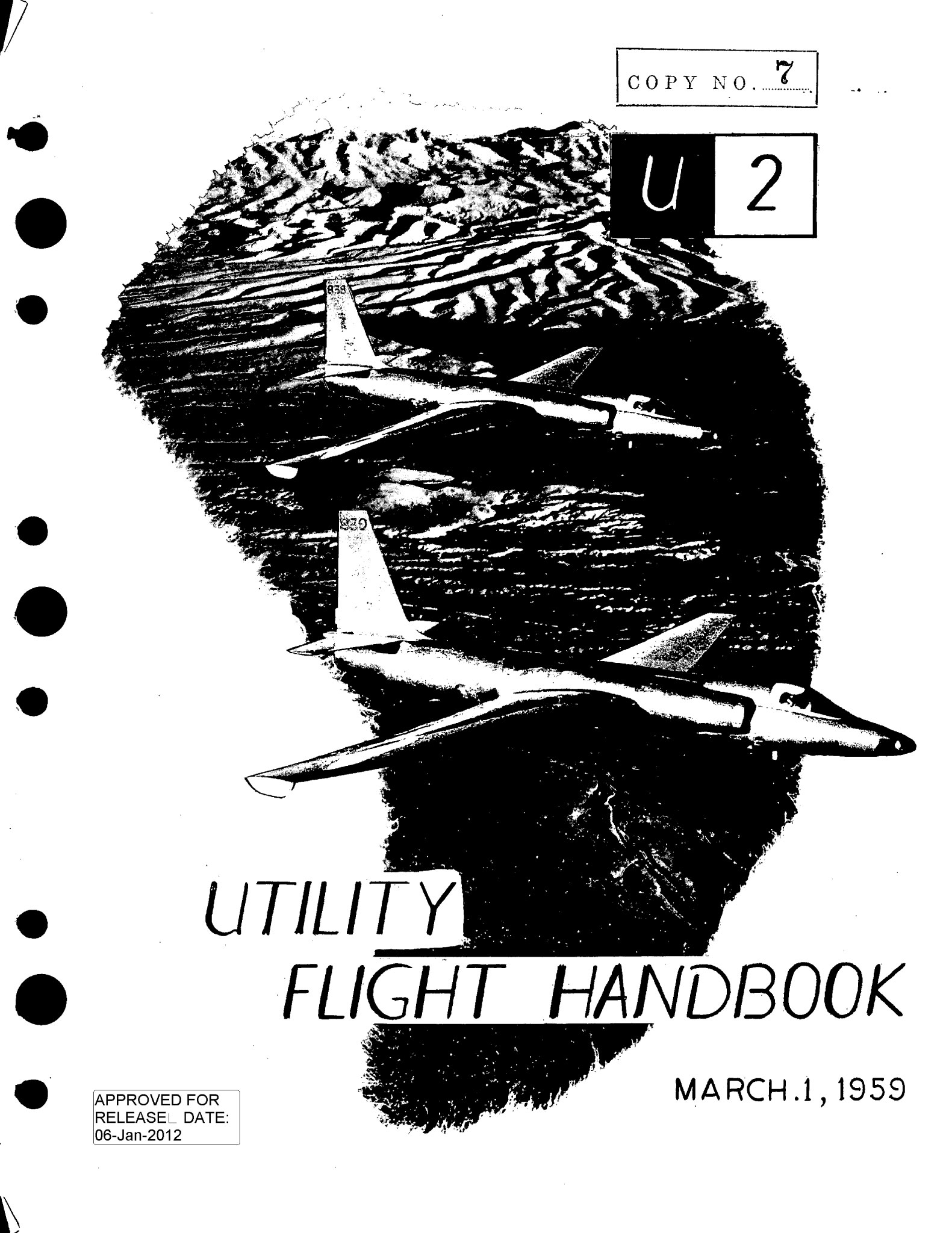
Utility Flight Handbook, March 1959 In spite of the problems, or maybe because of them, Powers and the rest of the pilots loved the U‑2. It could take off in less than 1,000 feet, climb at an angle of better than 45 degrees to over 70,000 feet, and maintain that altitude for 4,000 miles. Once, from high above the Colorado River in Arizona, Powers could see the California coast from Monterey halfway down Baja. U‑2 pilots made it a daily practice to exceed the international altitude record set in 1955 by an English Electric Canberra at 65,889 feet, although, of course, U‑2 flights were not publicized. “There was only one thing wrong with flying higher than any other man had ever flown,” Powers would recall later. “You couldn’t brag about it.” 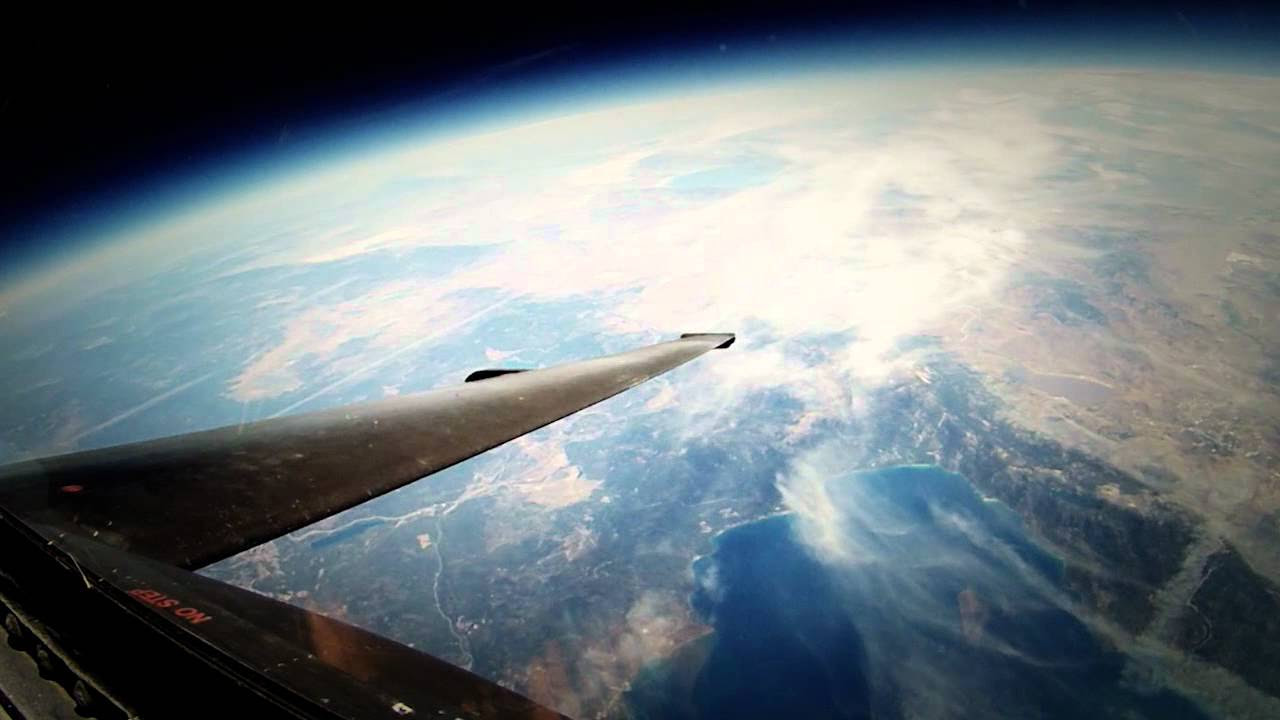
View from a U‑2 at 70,000 feet President Eisenhower had the same problem. He could imagine the headlines in The New York Times—let alone Pravda—if the world discovered that benevolent Uncle Sam was violating Soviet airspace. The CIA assured him that the plane had two or three years before Soviet antiaircraft technology caught up with it, and in the unlikely event of an accident, the Russians would be left with no proof of American duplicity—neither the U‑2 nor its pilot would survive. In fact, arguing it would never be so safe again, the CIA advocated an initial mission over Moscow. When were the first U‑2s shipped to Europe? I have no idea. When did the first U‑2 overflight take place? I have no idea. On July 4, 1956, a U‑2A out of Wiesbaden, Germany, overflew both Moscow and Leningrad. Operation Overflight became a reality. The CIA had hoped the U‑2—with wings so long they reflected primarily high-frequency, rather than radar, waves—would prove immune not only to attack but to detection. But National Security Agency listening posts in Europe could track the plane’s progress as measured by the activation of Soviet radar stations. Actual U-2 spy photos of Russia’s biggest cities. (Click captions for modern satellite views.) Had the U‑2 carried nuclear weapons—and Moscow could not know it didn’t—the USSR would be helpless. Unable to admit American planes (conceivably carrying nuclear weapons) could overfly the motherland at will, Khrushchev did not publicize the incident. He did, however, make his feelings known to Eisenhower. Neither man deluded himself that was the end of it. For his part, Eisenhower opted to approve further overflights only on a contingency basis. Khrushchev issued an immediate directive to his armed forces: “Improve rockets! Improve fighter planes!” What is your unit called? Detachment 10-10. Where is it based? Incirlik. Where is lncirlik? Adana, Turkey. 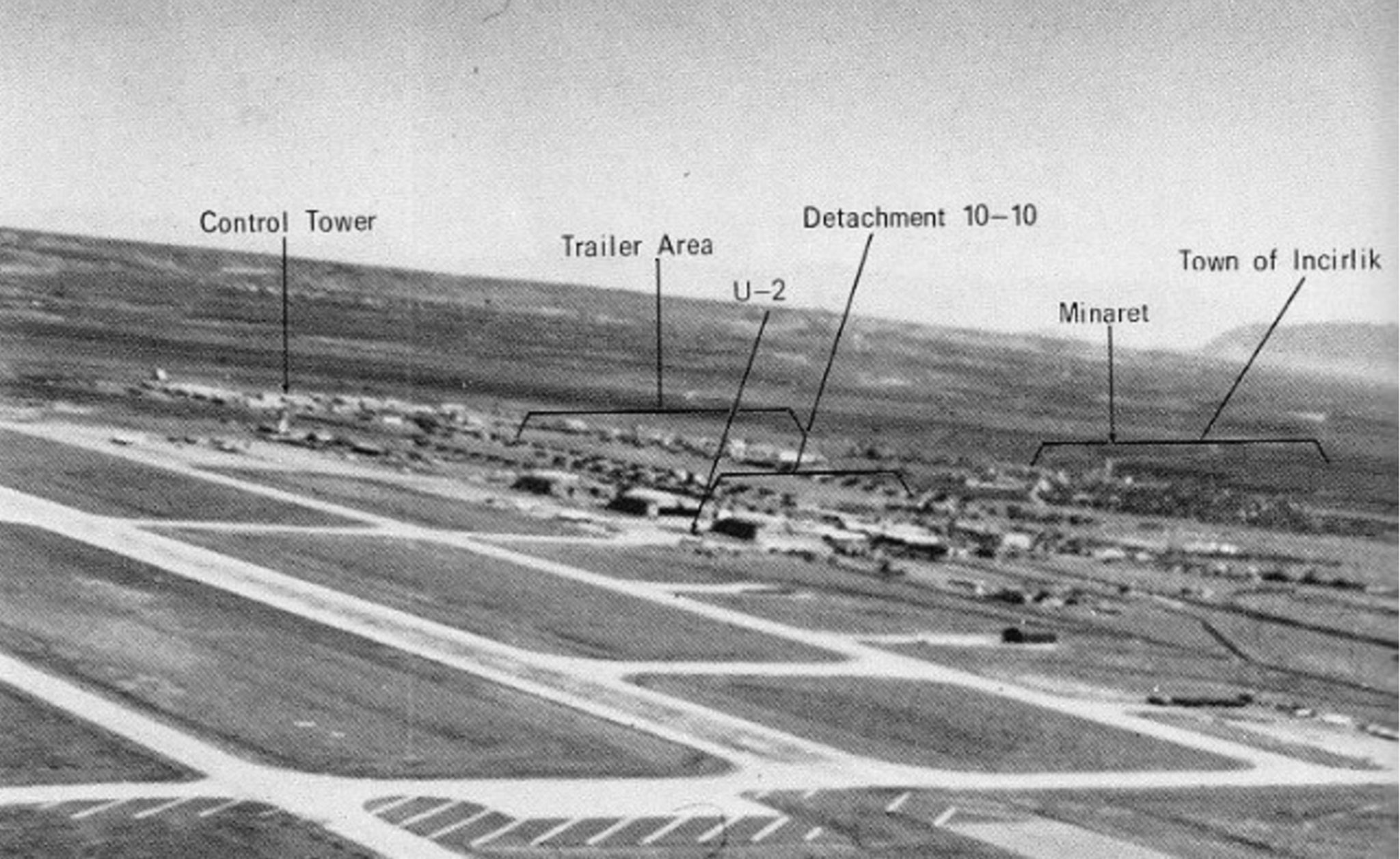
Incirlik AFB, late 1950s Powers and his squadron mates, then given the CIA redesignation “Detachment 10-10,” found southern Turkey remarkably like southern Nevada, except more remote. In August 1956, lncirlik was primarily a refueling stop for U.S. Air Force planes passing through to more important destinations. Housed in an isolated hangar away from the main base, Detachment 10-10 kept up the pretense of weather research but functioned as a combined Air Force/CIA operation, with an Air Force colonel commanding officer, a CIA executive officer, and suspiciously tight security. At 70,000 feet, U‑2 pilots could see more than 300 miles into the Soviet Union without even crossing the border. From lncirlik, U‑2s ranged eastward as far as Pakistan and as far west as Albania. During the 1956 Suez Crisis they monitored the troop movements of America’s allies, Britain and France—a secret that, if discovered and made known by the Soviets, might have ruptured the NATO alliance—and Powers himself overflew the first daylight fighting in the Sinai. How many missions did you fly along the border? One or two in 1956, maybe six to eight in 1957, 10 or 15 each in 1958 and 1959, and several in 1960. How many flights have you made over Russia? This was my first. How many? Just one. Actually, Powers made his first overflight, the first out of lncirlik, in late 1956, to determine Soviet intentions in the wake of the Hungarian uprising. He remembered later, “There was no abrupt change in the topography, yet the moment you crossed the border you knew the difference.” In the years ahead he would come to know the feeling well. No sooner did U‑2s reveal the myth of the bomber gap (it was now believed the several Bison formations seen at the 1955 May Day demonstration were an illusion, that only one formation existed, which had circled out of sight and back again) than the Russians successfully fired an ICBM and a pair of Sputnik satellites. From on high, U‑2 pilots had a spectacular view of night launches lighting up the cloudscape for hundreds of miles in all directions. The bomber gap became the missile gap. When the U‑2 pilots were asked to extend their contracts another year, they insisted their families be allowed to join them at lncirlik. Powers’ wife, Barbara, much to the annoyance of his superiors, had already followed him to Athens, where he had told her he was stationed. The CIA had stashed her in an out-of-the-way job at Wheelus Air Force Base, Tripoli. The pilots’ tours were extended a year at a time in 1957, 1958 and 1959. The U‑2s alerted the Strategic Air Command (SAC) to 17,000 new potential targets and revealed the missile gap to be as much a Soviet propaganda coup as the bomber gap. Many Soviet rocket launches failed explosively, and production was proceeding at nowhere near the pace claimed by Moscow; by late 1959, the Soviets still did not have a single operational ICBM. Eisenhower, however, could not dispel American fears without divulging violations of Soviet airspace. It was a typical Cold War situation: neither side happy with the continuing overflights, neither side able to stop them. Neither side could even admit to the existence of the U‑2. Publicly, both sides attempted to reach detente. In 1959, Khrushchev visited the United States and Vice President Richard M. Nixon visited the Soviet Union, and a major summit was scheduled for Paris in May 1960. There, Eisenhower hoped to reach a major arms-limitation agreement-what would amount to his crowning achievement in two terms as president, almost guaranteeing a Republican victory in the 1960 election and his own place in history. To avoid sullying this rosy picture, he forbade further U‑2 missions over Russia. 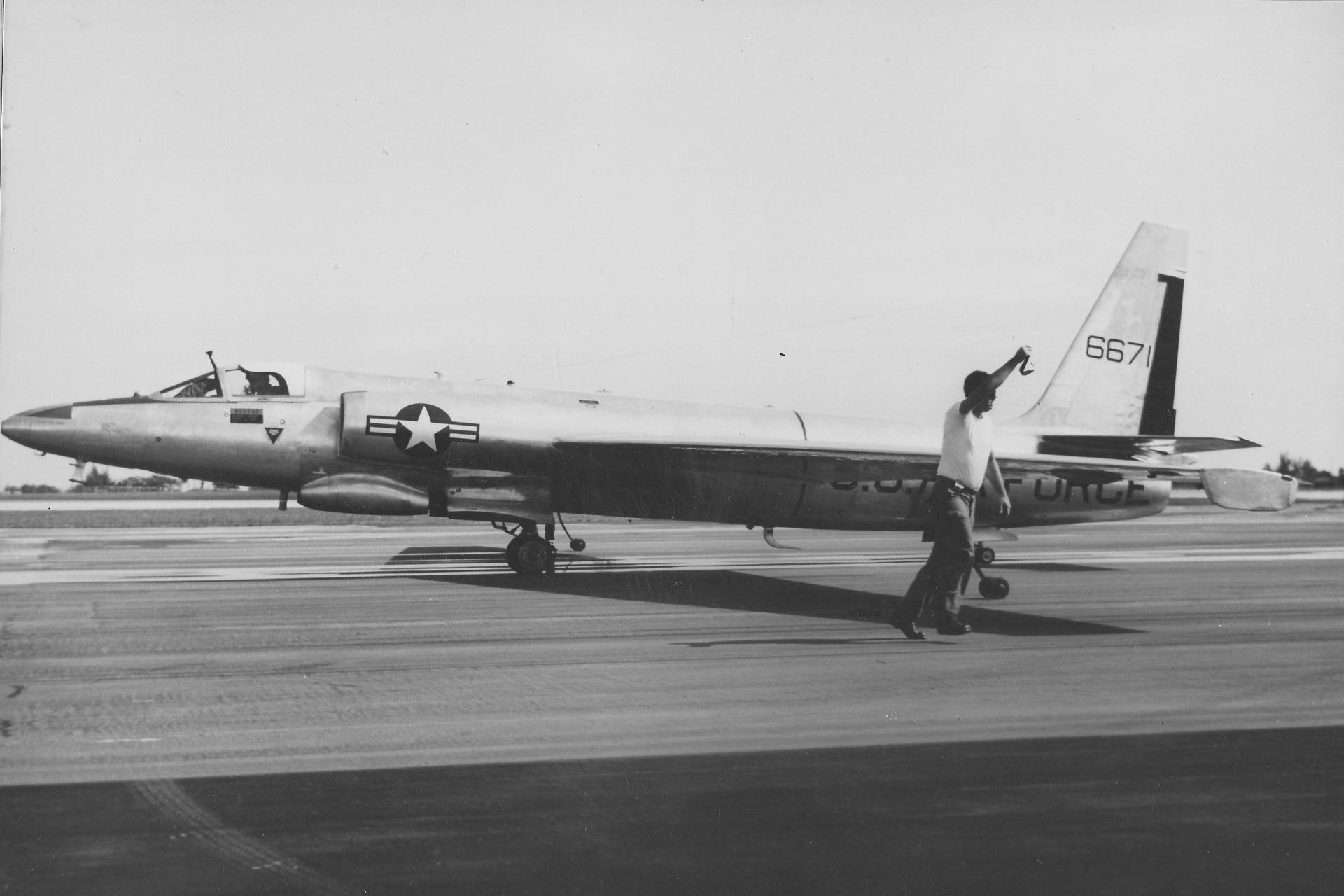
USAF WU-2A taking off Twelve production U‑2A airframes were converted by the Air Force to WU-2A models, with air intakes mounted in the port side of the Q-bay. The High Altitude Sampling Program (HASP) scoop housed air filters to sniff for radioactive fallout particles lofted into the upper atmosphere by Soviet nuclear tests. Operation Overflight was nearly through. With the impetus of Soviet competition, America’s own space program was moving ahead, if only in fits and starts. By the end of the year, it was hoped, all overflights of Russia could be made by spy satellites. The Air Force (which had turned down Lockheed’s original design) was now angling for control of all U‑2 operations; the KGB had compromised a German detachment, forcing the CIA to move those pilots to Incirlik. The CIA, however, wanted a last look at suspected new ICBM sites under construction in certain areas of the northern Ural Mountains and White Sea at Tyuratam, Sverdlovsk, and especially Plesetsk, 600 miles north of Moscow, where it believed ICBMs were already operational. At that latitude, the angle of sunlight allowed effective photography only from April though July; if a U‑2 didn’t make the flight then, the attempt would have to wait until 1961. Eisenhower agreed to allow only two overflights, to take place in April 1960, well in advance of the Paris summit. The first, on the 9th, received surprisingly little attention from Moscow. It is possible that Khrushchev, who had been extolling Eisenhower’s virtues to the Communist elite, was humiliated before his considerable Kremlin opposition by this latest example of American deceit, and withdrew from public view to consider his options. Russian silence encouraged the CIA, which seemed determined to make its last mission a big one. To compensate for the loss of the German operation and to increase coverage of Red China, the agency had set up bases in Taiwan, at Atsugi in Japan, Lahore and Peshawar in Pakistan, and Bodö in Norway. Now they proposed “Operation Grand Slam,” to send a U‑2 completely across the Soviet Union, from Peshawar to Bodö. And they wanted Francis Gary Powers to fly it. 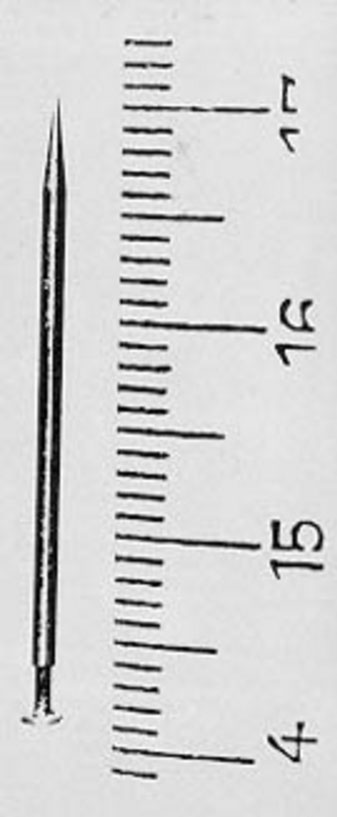
Powers’ infamous poison needle. The wider shaft is actually an inert sheath for the needle inside. The needle was put on display in Moscow. By that time, Powers was the most experienced U‑2 pilot in the world; for him, overflights had become routine. In the beginning he had worried about the possibility of being shot down. Horror stories of Korean War POWs—brainwashing and torture—had led the CIA to furnish U‑2 pilots with cyanide capsules and the infamous poison needle hidden in a bisected silver dollar. Powers never took them along. Like the other pilots, he considered their use optional, not mandatory. Ironically, as the threat increased, Powers had become more and more cavalier. The morning of his departure for Peshawar, he even packed his wallet, with an assortment of American, German and Turkish money, for his layover in Norway; his wife packed him a lunch for the shuttle flight to Pakistan. Their main concern was whether he would be back in Incirlik in time for a party on Sunday night, May 1. The overflight was scheduled for Thursday, April 28; Powers figured he’d be back in plenty of time. Bad weather along the planned route caused a 24-hour delay, and then another, and then another. On Sunday morning, Powers started the pre-flight procedure, again figuring the mission would be scrubbed. He awoke at 2 a.m. to a breakfast of bacon, eggs and toast—high protein, low residue; to save weight the U‑2 carried no provision for pilot relief. Powers spent a half-hour or so as he had so many times before, getting worked into a primitive, rubberized partial-pressure suit, and pre-breathing pure oxygen to prevent the bends. His commanding officer asked if he wanted to take the needle along; this time something made him say yes. 
U-2C No. 360, Air Force serial No. 56-6693 The only photos of this aircraft are of its wreckage, on display at the Central Armed Forces Museum in Moscow. Opinions differ on its markings and equipment on May 1. The wreckage indicates the aircraft had the interim enlarged intakes for the J75 engine, vs. the later “coke bottle” inlets, and did carry GIANT STRIDE slipper tanks under the wings, but not the full-length dorsal spine fairing of later U‑2C models. Whether it bore the ID number on the fin is open to debate. 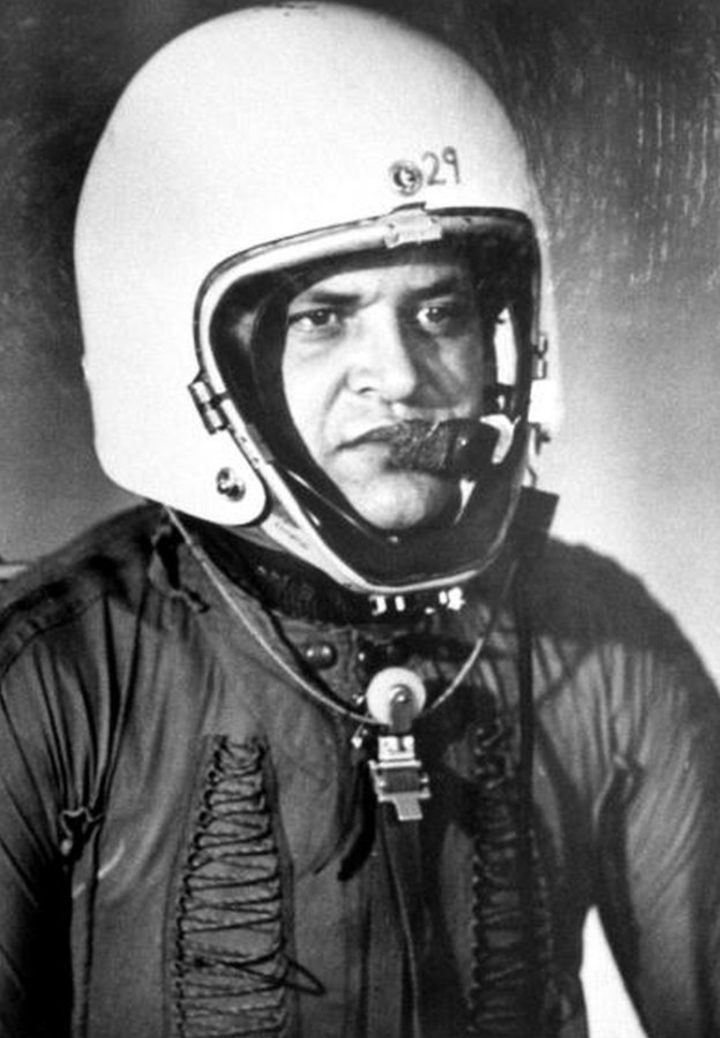
Francis Gary Powers, January 1960. Later that year this helmet and flight suit would be put on display in Gorky Park Hall, Moscow Shortly after 5 a.m., lugging a portable oxygen bottle, he was driven out to his plane. Since 1957 the natural metal finish of the U‑2s had been covered in blue-black, radar-absorbent ferrite paint, devoid of distinguishing insignia. This was Aircraft No. 360, Air Force serial No. 56-6693, a U‑2C (essentially a U‑2A “upengined” with a new Pratt & Whitney J-75-P-13A turbojet to compensate for the ever-increasing mission load). Powers had originally been slated to fly the unit’s best aircraft, but after the constant shuttling back and forth to Peshawar during the previous days’ delays it had accumulated excessive flight hours and had been grounded for routine maintenance. The U‑2’s individualized construction emphasized each planes’ particular vices and virtues, and No. 360 was known among the lncirlik pilots as a dog, with chronic fuel-feed problems. The previous September, during a record-high flight over Japan, it had flamed out 10 miles short of Atsugi and crash-landed on a glider-club strip. Powers sweltered in its cramped cockpit while the ground crew finished its checks of the aircraft and Q-bay. The last system activated was the 2.5-pound explosive self-destruct charge behind the pilot’s seat, which, in the event the plane went down, would be armed and set to explode after a 70-second delay, from the cockpit. (The Russians and American cynics would later suggest the timers were set to zero to destroy both planes and pilots, but the delay interval was checked and verified to the pilot’s satisfaction before every flight.) 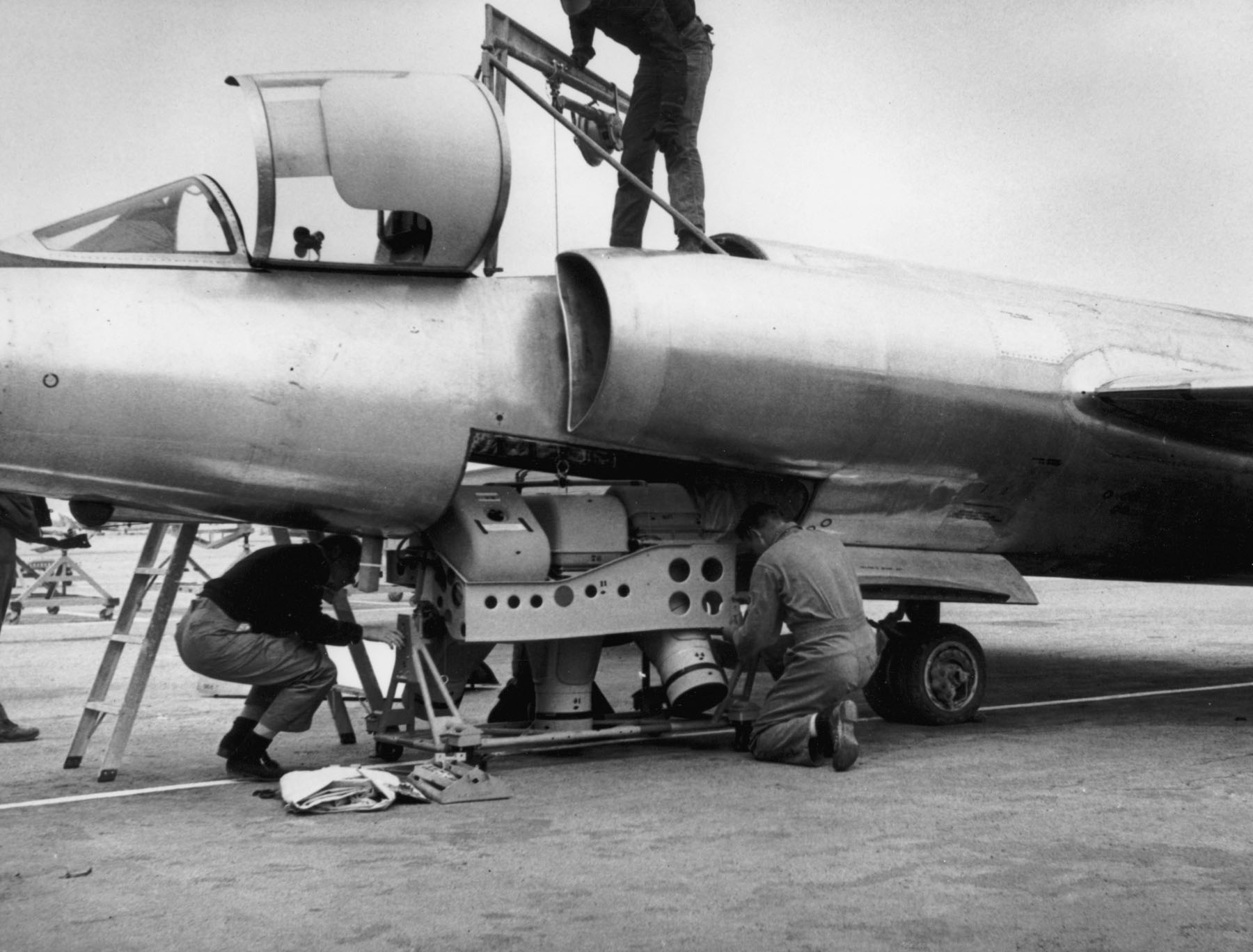
The U‑2’s camera installation, for security and utility reasons completely removable, consisted of three cameras fixed to look down, right, and left. By 6 a.m. all systems were go. Powers awaited only permission for takeoff, which he understood had been held up in Washington. By 6:20a.m., Powers was certain the mission had been scrubbed and was looking forward to getting out of his sweat-soaked flight suit when word came in, “Go for takeoff.” The J75 fired up with its distinctive scream. With the instruments reading properly, canopy down and locked, Powers gathered speed down the runway and lifted off, the midwing outrigger “pogo” wheels dropping clear, the U‑2 soaring up in the characteristic parabolic-shaped climb. The Khyber Pass dropped below. On Powers’ right, the Himalayas stretched away toward Red China; on his left, the Hindu Kush, toward the Middle East. Down below it was still night; above, the sun shone white-hot and sharp in a sky gone from blue to blue-black. Outside, the temperature dropped to 60 below; air pressure was so low his blood would boil and his body burst if his cabin lost pressurization or his suit lost its integrity. Up, up, up. 
Thirty minutes after takeoff, he checked in with Peshawar—two clicks on the transmitter to signal all systems A-OK. One click in reply would mean proceed as planned; three, mission scrubbed. One click came back. Now at his operational altitude, Powers crossed the Soviet border near Dushanbe, ex-Stalinabad. Far below, clouds lay up against the mountains’ north faces like frothy seas against a shore. In the slightest turbulence the U‑2’s fragile wings flapped like a bird’s—in September 1956 two curious Canadian fighter planes, buzzing a low-flying U‑2 over Germany, had inadvertently destroyed it with their turbulence—but up where Powers was flying there was no weather. Just miles and miles of smooth, uniform air. His course was marked in blue on his route maps, with target areas, including camera-control instructions, in red, and escape routes to alternate bases in brown. Flying by time and compass, Powers steered over the socked-in landscape toward Tyuratam, about 30 miles east of the Aral Sea. 
Although the clouds obscured the ground, they could not mask the U‑2 from Soviet radar. In Moscow, Khrushchev was awakened by a telephone call from his defense minister, Marshal Rodion Malinovsky, who said, “If our anti-aircraft units can keep their eyes open and stop yawning long enough, I’m sure we can knock the plane down.” Powers was an hour and a half into the flight when he saw the first sign that he had been spotted: a white contrail below, stretching out behind an invisibly small, supersonically fast jet fighter, coming toward him. Within a few minutes he saw it again, this time going in the same direction, clearly tracking him. 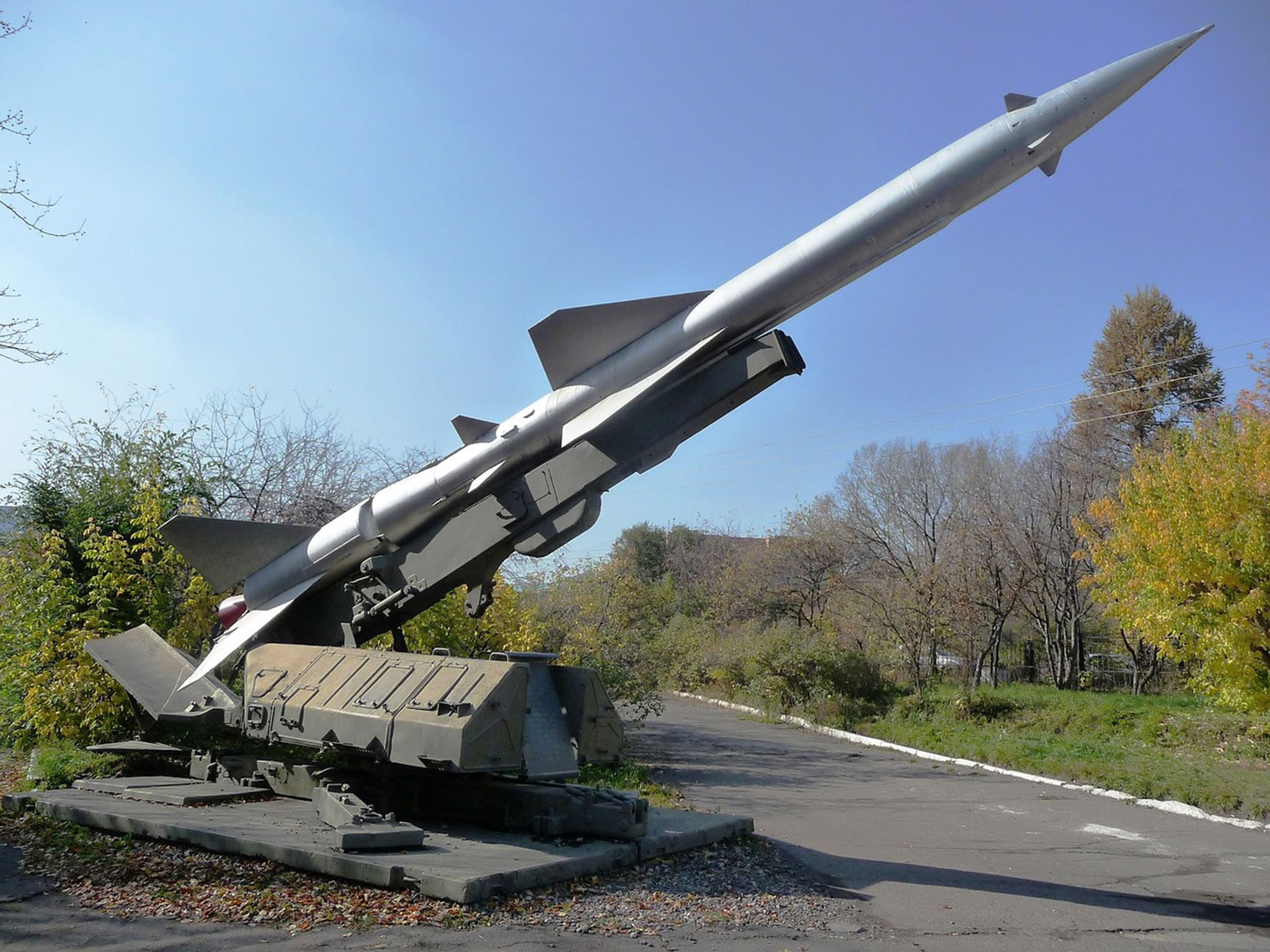
S�-�7�5� �D�v�i�n�a� �(�R�u�s�s�i�a�n�:� C-�7�5�;� �N�A�T�O� �r�e�p�o�r�t�i�n�g� �n�a�m�e� �S�A�-�2� �G�u�i�d�e�l�i�n�e�)� He had little to fear from Soviet fighters, although the new MiG-21 could in a zoom-climb carry AA-2 “Atoll” air-to-air missiles to 70,000 feet. More worrisome was the new SA-2 “Guideline” surface-to-air missile (SAM), with a ceiling reportedly comparable to the U‑2’s. American experts believed that all of those weapons’ control surfaces were too small to permit maneuvering in the thin air 13 miles above the earth; coasting along unguided ballistic flight paths, they would simply be out-turned by the U‑2. However, a jamming device had been installed in the spy planes’ tails that would defeat a radar-guided air-launched missile. Powers continued along undisturbed. 
The SS-6 missile launch site and blast pit at Baikonur Cosmodrome, Tyuratam, Kazakhstan. Source: CIA. See also this view. There was a gap in the clouds near, but not over, Tyuratam. For what it was worth, Powers duly tripped the plane’s cameras and turned north. He was still 50 miles short of Chelyabinsk when the U‑2’s nose suddenly lurched upward. The autopilot had malfunctioned. A lesser pilot might have lost control then and there, as the plane faltered near its stalling speed. Powers disengaged the autopilot and brought the nose down again, but he could not get the autopilot to work for more than a few moments at a time. 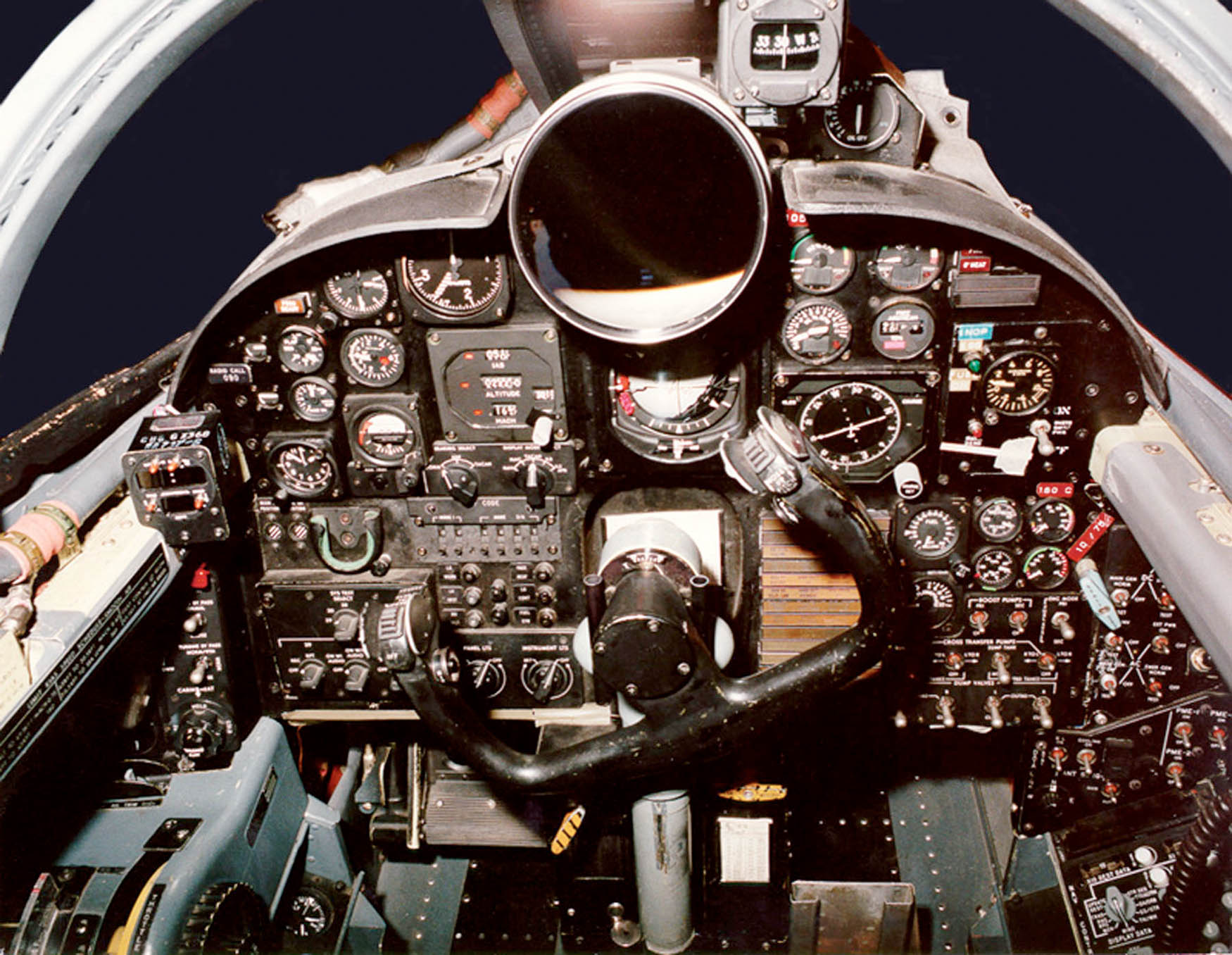
U-2 cockpit, dominated by the large drift sight, top center, which provided a 360-degree view beneath the aircraft as a navigation aid Missions had been aborted for less. Going on meant manual control—2,500 miles of navigation by dead reckoning, switching the cameras on and off at estimated intervals and making notes for the debriefing, all the while carefully keeping the aircraft within the few knots between top and stall speeds. Aborting meant flying 1,500 miles back to Peshawar, then Adana and ultimately the United States as Operation Overflight wound down. But Powers was past the worst of the weather. And ahead was Sverdlovsk, the small village on the Volga now grown into the Soviet Union’s 10th largest city, an industrial/transportation center over which no U‑2 had yet flown. Powers would write, “I decided to go on and accomplish what I had set out to do.” Once past Chelyabinsk, he made a 90-degree left turn—gingerly, because the U‑2’s speed margin was so narrow and its wingspan so large that in a turn its outer wingtip could experience Mach buffeting even as the inner one stalled—and he rolled out in position to pass over the city’s southwest quarter. 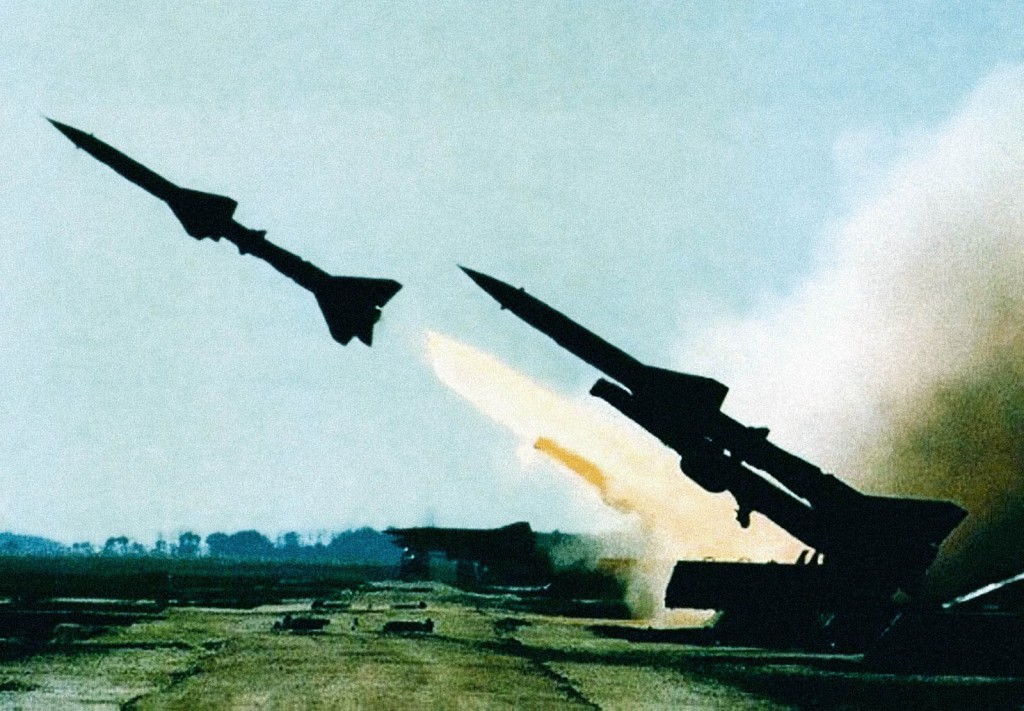
Over the next decades the SA-2 “Guideline” would become the nemesis of Western fighters from Vietnam to the Middle East MiG-19s already were attempting zoom-climb intercepts. Later it was thought the U‑2’s radar jammer, effective against air-launched missiles, may actually have helped the SAM-guidance radar lock on. No fewer than 14 SAMs were fired simultaneously at the U‑2. Powers had noted an airfield below not marked on his maps. He was set to pass over it when he felt a violent thump from behind. An orange glow filled the cockpit, and Powers blurted, “My God, I’ve had it now!” Bridge of Spies (2015) Though the scene differs in detail from Powers’ account of events and has actor Austin Stowell piloting what appears to be a U‑2R, which didn’t fly until 1967, it captures the crucial seconds of the U‑2 Incident. 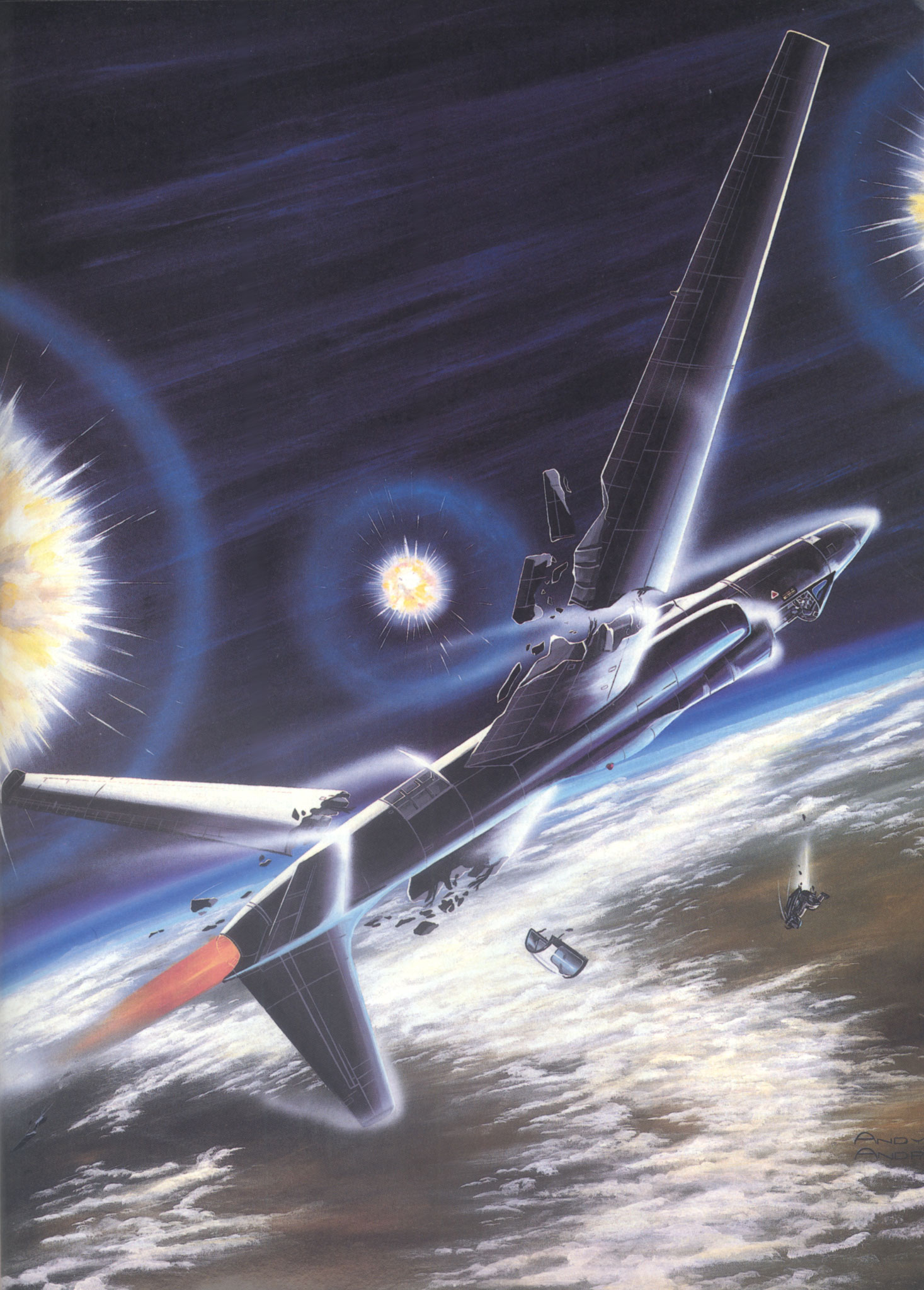
Though the U‑2 was equipped with an ejection seat, Powers didn’t trust it, and actually climbed out of the aircraft as it spun down. None of the missiles had hit, but a near-miss had caused the plane’s right stabilizer to fail. (A SAM did manage to down one of the pursuing MiG-19s.) The U‑2 started to dive, gently at first, then its fragile wings failed and it began to tumble wildly. Powers’ suit inflated—the cabin had lost pressurization. The plane was done for. Hurled about the cockpit, Powers managed to flip up the safety covers on the destruct switches but did not flip the switches themselves. Realizing he could be trapped in the plane, he decided he’d better get ready to eject first. He had never trusted the ejection seat. To save weight it had been deleted from the original design; then it was found that at the U‑2’s extreme cruising altitude the plastic canopy froze so hard a pilot could be killed if his seat fired him against it. The seat had been redesigned to punch through the glass but not, as in later models, to pull the pilot’s limbs in tight before firing. If his legs were forced out by the plane’s spin, Powers estimated the canopy railing would cut both of them off about three inches above the knee. Very near panic, Powers forced himself to stop and think, only then realizing he could simply climb out. Nose up and spinning, the plane was passing through 34,000 feet. Powers released the canopy. Again he thought of the destruct switches, but decided to release his belt first—and was immediately hurled halfway out onto the windscreen, held only by his air hoses. His facemask frosted over. He tried to feel his way to the switches, but now couldn’t reach them. He wondered how far the plane had fallen. “I’ve just got to save myself now,” he thought, and tore himself free. Then he was floating, until his parachute opened automatically at 15,000 feet. He opened his faceplate and saw the remnants of his plane fluttering toward the Russian countryside, which looked very much like his Virginia home. Powers tore up his maps and, realizing a coin would be the first thing taken from him, pocketed the poison pin and threw the phony silver dollar away. Narrowly missing a set of power lines, he came down hard in a plowed field near a town and was immediately surrounded by curious villagers. Within hours Francis Gary Powers was being interrogated in Moscow. The preliminary interrogation was finally over, and the weary prisoner was taken to his new home, an 8-by-15 foot cell with a steel-reinforced oak door pierced by a peephole. Lit by a single naked light bulb, its only furnishing was a lumpy, steel-slatted bed. By admitting to what the Soviets probably already knew, or could easily find out, Powers hoped he could continue to conceal greater secrets: the missions to check on France and Great Britain during the Suez Crisis; the U‑2’s true performance; the real extent and results of American spy flights. Yet Powers had not realized until then how little training the U‑2 pilots had in counter-interrogation. And he could not forget the counsel of the Detachment 10-10 intelligence officer who had said: “You may as well tell them everything, because they’re going to get it out of you anyway.” 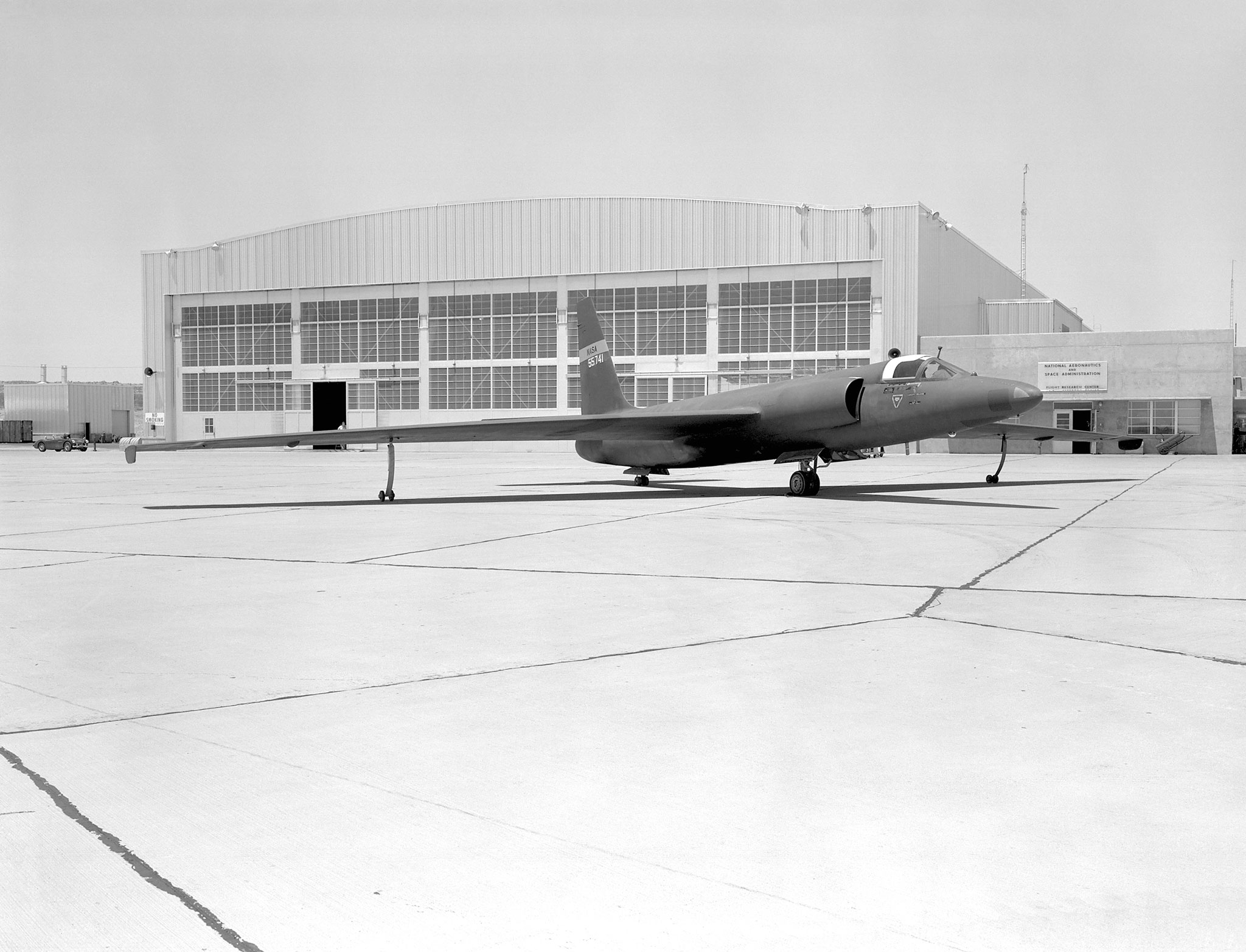
On May 6, 1960 this U‑2 was rolled out in NASA markings, with a fictitious serial number, and displayed for the news media at Edwards AFB to back a cover story about a U‑2 conducting weather research that “may have strayed off course after the pilot reported difficulties with his oxygen equipment.” 
This 1962 Corona spysat photo shows the first Soviet ICBM site to be identified by spy satellite, the SS-7 missile base at Yurya, USSR. Meanwhile the Soviets demonstrated their skill at propaganda. Allowing Eisenhower to believe the U‑2 pilot dead and to lie about American involvement, Khrushchev then trotted out his prize trophies: the wreckage of the U‑2 and its pilot, alive and well. He allowed the 1960 Paris Summit to proceed as scheduled, only to storm out when Eisenhower refused to apologize. The American president, by then secure in the knowledge that satellites could take over, finally agreed to end overflights by spy aircraft. Powers was subjected to the showiest of Moscow show trials, in which even his defense lawyer worked for the prosecution and his guilt was a forgone conclusion. The only question was whether his crime merited capital punishment. The U‑2 Incident alters the Cold War. Enlarge Even when faced with death, Powers refused to denounce his country. Warned that Soviet justice looked more kindly on the penitent, he very publicly proclaimed himself deeply repentant and profoundly sorry. The admission won him a sentence of ten years, but he was to regret making it for the rest of his life. 
Powers in his first public appearance after his release by the Russians on February 10, 1962, holding a U‑2 model as he testifies beforethe Senate Armed Services Committee in Washington, D.C., March 6, 1962. (AP Photo) John F. Kennedy defeated Vice-President Richard Nixon in the 1960 election, in large part due to the lingering taint of the U‑2 affair. In February 1962 his administration agreed to trade Soviet spy Rudolf Abel for Powers. Powers returned to the USA to find himself practically on trial again. Why had he made such a humiliating admission? Why hadn’t he destroyed the U‑2 as ordered? Why hadn’t he commited suicide to avoid capture? How was it he was shot down in the first place, when no Soviet missile could reach the height at which he was supposedly flying? Had the U‑2 flamed out and dropped too low, or had Powers accidentally—or intentionally—taken it down? Was he a defector, perhaps even a double agent? Despite the histrionics of the press, Powers was cleared by the CIA and a congressional panel. He divorced his wife, rejoined the CIA and remarried, but eventually joined Lockheed as a test pilot. Continuing questions over the U‑2 affair led him to write his memoirs. It took years for the CIA to clear publication, and when the final product didn’t meet with approval Powers found out the hard way who signed his Lockheed paycheck: The Agency had him fired. In 1976 he was hired to fly a Los Angeles TV station’s helicopter for aerial news coverage. On 1 August 1977, while hovering over a softball game only a few miles from the Lockheed Skunk Works, a faulty fuel gauge evidently led him to run out of gas. Some of the boys playing below swore he managed to guide the chopper, even in its death dive, to miss them. He was posthumously awarded the Silver Star. Powers’ widow Sue campaigned to have him buried at Arlington National Cemetery, and the CIA backed her. President Jimmy Carter approved the request. Francis Gary Powers had fought the Cold War from the front lines. 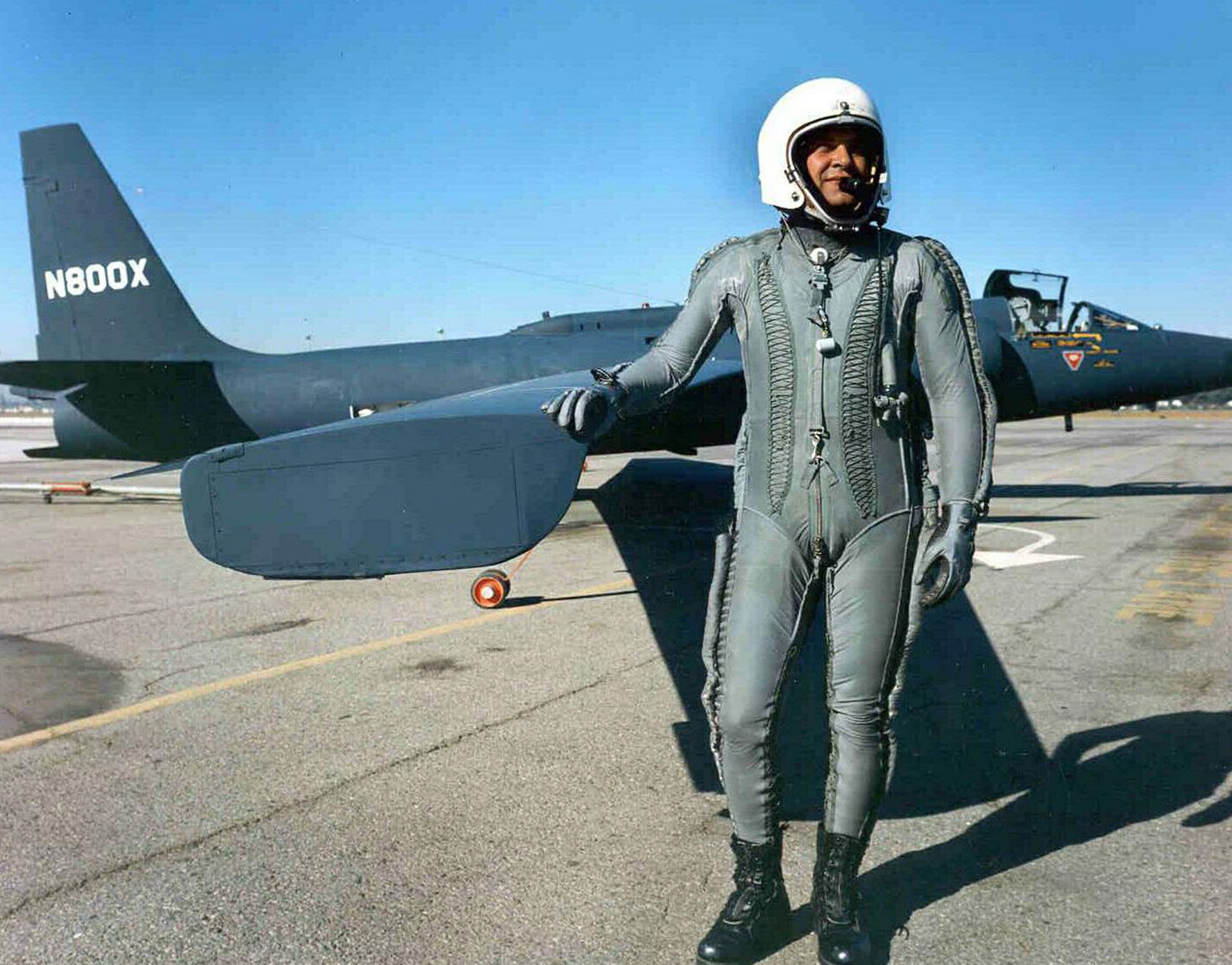
Bibliography
About the authorAuthor/illustrator/historian Don Hollway has been published in Aviation History, Excellence, History Magazine, Military Heritage, Military History, Civil War Quarterly, Muzzleloader, Porsche Panorama, Renaissance Magazine, Scientific American, Vietnam, Wild West, and World War II magazines. His work is also available in paperback, hardcover and across the internet, a number of which rank extremely high in global search rankings. More from Don Hollway:
|
